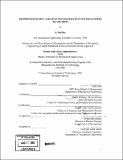| dc.contributor.advisor | Daniel Whitney and Roy Welsch. | en_US |
| dc.contributor.author | Bar, S. Neil (Saumen Neil) | en_US |
| dc.contributor.other | Leaders for Manufacturing Program. | en_US |
| dc.date.accessioned | 2007-04-03T17:15:37Z | |
| dc.date.available | 2007-04-03T17:15:37Z | |
| dc.date.copyright | 2006 | en_US |
| dc.date.issued | 2006 | en_US |
| dc.identifier.uri | http://hdl.handle.net/1721.1/37136 | |
| dc.description | Thesis (M.B.A.)--Massachusetts Institute of Technology, Sloan School of Management; and, (S.M.)--Massachusetts Institute of Technology, Dept. of Mechanical Engineering; in conjunction with the Leaders for Manufacturing Program at MIT, 2006. | en_US |
| dc.description | Includes bibliographical references (p. 100). | en_US |
| dc.description.abstract | Sikorsky Aircraft is undergoing a lean transformation as its helicopter blade line is relocated from Stratford to Site B. Value Stream Mapping is a vital tool to eliminate sources of waste in the existing blade shop and to create a vision for the future state production system. This thesis briefly focuses on the enterprise to provide a sound understanding of the business and aerospace industry, describing the flow of information from customer proposal through product delivery. Detailed value stream maps for the main and tail rotor blades are then analyzed from an operations perspective to uncover major time and process delays. Implementation is a topic of in-depth review within this thesis. As a management tool, Value Stream Mapping does not reinforce roles, responsibilities, and accountability to achieve the future state vision. Therefore, a set of guidelines are followed to coordinate kaizen initiatives. Examples consist of matrices to quantify and prioritize opportunities, charters to organize teams and deliverables, and work plans to track progress and metrics. The introduction of management tools aid in satisfying monthly throughput targets while establishing a precedence for upcoming lean programs. | en_US |
| dc.description.abstract | (cont.) The thesis concludes with the design of a lean production system, which includes a new cellular layout. The future operating system is intended to align Sikorsky's lean flow philosophy with manufacturing capabilities. Recommendations to further enhance factory operations are evaluated in the final chapters along with an action list for on-going projects. A wrap-up for sustaining change is also discussed through a formal critique of the management organization. | en_US |
| dc.description.statementofresponsibility | by S. Neil Bar. | en_US |
| dc.format.extent | 100 p. | en_US |
| dc.language.iso | eng | en_US |
| dc.publisher | Massachusetts Institute of Technology | en_US |
| dc.rights | M.I.T. theses are protected by copyright. They may be viewed from this source for any purpose, but reproduction or distribution in any format is prohibited without written permission. See provided URL for inquiries about permission. | en_US |
| dc.rights.uri | http://dspace.mit.edu/handle/1721.1/7582 | |
| dc.subject | Sloan School of Management. | en_US |
| dc.subject | Mechanical Engineering. | en_US |
| dc.subject | Leaders for Manufacturing Program. | en_US |
| dc.title | Business expansion and lean transformation for helicopter blade shop | en_US |
| dc.type | Thesis | en_US |
| dc.description.degree | S.M. | en_US |
| dc.description.degree | M.B.A. | en_US |
| dc.contributor.department | Leaders for Manufacturing Program at MIT | en_US |
| dc.contributor.department | Massachusetts Institute of Technology. Department of Mechanical Engineering | |
| dc.contributor.department | Sloan School of Management | |
| dc.identifier.oclc | 85812315 | en_US |
